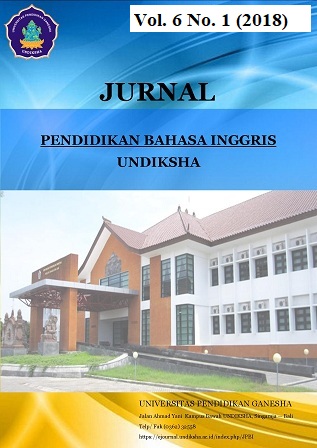AN ANALYSIS OF CODES USED BY THE MOSLEM SPEECH COMMUNITY OF TELAGAMAS VILLAGE, SUBAGAN, KARANGASEM
DOI:
https://doi.org/10.23887/jpbi.v6i1.20393Abstract
ABSTRACT
This qualitative research aimed at identifying kinds of code that are used by Moslem people in Telagamas Village and analyzing how they used those codes to communicate with each other and other people around this village. There were three domains chosen in this study, namely family, friendship, and neighborhood. The data were collected using two techniques, namely observation, and interview technique. There were three conversations recorded in all domains of language used and the data were analyzed using observation sheet in a form of table. The results of the study show that there were 3 kinds of code used by the Moslem people in Telagamas Village based on 610 utterances that had been analyzed, namely Sasak language, Balinese, and Indonesian. In addition, there were 46 utterances categorized as code switching and code mixing used by the villagers. There were 32 utterances (70%) that belonged to code switching and 14 utterances (30%) to code mixing.
Keywords: Code, Code Switching, Code Mixing
References
Alvanoudi, A. 2017. Language contact, borrowing and code switching: A case study of Australian Greek.Jornal of Greek Linguistics: 1-42.
Bryman, A. (2004). Encyclopedia of Social Science Research Methods: Triangulation. Thousand Oaks: SAGE
Denzim, N. K. (1970). The research act in sociology: A theoretical introduction to sociological methods. London, England: Butterworths
Fishman, J. A. (1972). Language in sociocultural change. Standford: California. Stanford University Press. Pp. xvi+376
Gall, M.D., Gall, J. P., & Brog, W. R. (2003). Education research :An introduction(7th ed.). Bostom,MA: A & B Publications.
Holmes, J. A. (2001). Learning about Language: An Introduction to Sociolinguistics. Harlow: Pearson Education Limited.
Hatch, J. A. (2002). Doing Qualitative Research in Education Setting. State Albany: University of New York Press.
Handayani (2012) Handayani, I. G. A. S. 2012.Language Chaoice of Javanese- Balinese Mixed Marriage Families in Denpasar: A Sociolinguistic Study. Singaraja: Ganesha University.
Lans, W. & Voordt, T. V. D. (2002). Descriptive Research. Ways to Study Architectural, Urban, and Technical Design. Delft: DUP science, p. 53-60.
Lunenburg, F. C. (2010). Communication: The process, Barriers, and Improving Effectiveness. Schooling, vol. 1, No. 1, p. 1-10.
Milroy, L. (1987a). Language and Social Networks, 2nd edn. Blackwell, Oxford.
Muysken, P. (2000). Bilingual speech: A typology of code mixing. Cambridge, UK: Cambridge University Press.
Roulston, K. (2013). Asking Questions and Individual Interviews. London: SAGE Publications Ltd.
Sapir. (1921). Language: An Introduction to the Study of Speech. New York: Harcourt, Brace. Bartleby.com
Setiawan, D. (2016). English Code Switching in Indonesian Language. Universal Journal of Education Reseacher 4, 1545-1552.
Sugiantari, N. P. A. Y. (2018). Code Switching and Code Mixing by The Government of Bali. RETORIKA: Jurnal Ilmu Bahasa, 4, 107-112. Retrieved from http://dx.doi.org/10.22225/jr.4.2.847.107-112.
Sugiyono. (2010). Metode Penelitian Pendidikan. Bandung: Alfabeta.
Sumarsih, Siregar, M., Bahri, S., & Sanjaya, D. (2014). Code Switching and Code Mixing in Indonesia: Study in Sociolinguistics. English Language and Literatur Studies, 4, 16.
Putra, D. N. (2013). Code Choice of People Living in Saren Jawa (Javanese Diaspora), Budakeling Village, Karangasem Regency: A Sociolinguistics Study. Singaraja: Ganesha University
Wardhaugh, R. 1986. An Introduction to Sociolinguistics. Great Britain: Hrtnolls Ltd, Bodmin.
Wardhaugh, R. (2002). An Introduction to Sociolinguistics. Oxford: Balcwell Publisher.
Wardhaugh, R., & Fuller, J. M. (2015). An Introduction to Sociolinguistics (Seventh Edn). WILEY Blackwell
Downloads
Published
Issue
Section
License
Authors who publish with the Jurnal Pendidikan Bahasa Inggris Undiksha agree to the following terms:- Authors retain copyright and grant the journal the right of first publication with the work simultaneously licensed under a Creative Commons Attribution License (CC BY-SA 4.0) that allows others to share the work with an acknowledgment of the work's authorship and initial publication in this journal
- Authors are able to enter into separate, additional contractual arrangements for the non-exclusive distribution of the journal's published version of the work (e.g., post it to an institutional repository or publish it in a book), with an acknowledgment of its initial publication in this journal.
- Authors are permitted and encouraged to post their work online (e.g., in institutional repositories or on their website) prior to and during the submission process, as it can lead to productive exchanges, as well as earlier and greater citation of published work. (See The Effect of Open Access)













